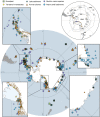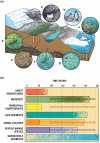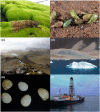Emerging biological archives can reveal ecological and climatic change in Antarctica
- PMID: 35900301
- PMCID: PMC9826052
- DOI: 10.1111/gcb.16356
Emerging biological archives can reveal ecological and climatic change in Antarctica
Abstract
Anthropogenic climate change is causing observable changes in Antarctica and the Southern Ocean including increased air and ocean temperatures, glacial melt leading to sea-level rise and a reduction in salinity, and changes to freshwater water availability on land. These changes impact local Antarctic ecosystems and the Earth's climate system. The Antarctic has experienced significant past environmental change, including cycles of glaciation over the Quaternary Period (the past ~2.6 million years). Understanding Antarctica's paleoecosystems, and the corresponding paleoenvironments and climates that have shaped them, provides insight into present day ecosystem change, and importantly, helps constrain model projections of future change. Biological archives such as extant moss beds and peat profiles, biological proxies in lake and marine sediments, vertebrate animal colonies, and extant terrestrial and benthic marine invertebrates, complement other Antarctic paleoclimate archives by recording the nature and rate of past ecological change, the paleoenvironmental drivers of that change, and constrain current ecosystem and climate models. These archives provide invaluable information about terrestrial ice-free areas, a key location for Antarctic biodiversity, and the continental margin which is important for understanding ice sheet dynamics. Recent significant advances in analytical techniques (e.g., genomics, biogeochemical analyses) have led to new applications and greater power in elucidating the environmental records contained within biological archives. Paleoecological and paleoclimate discoveries derived from biological archives, and integration with existing data from other paleoclimate data sources, will significantly expand our understanding of past, present, and future ecological change, alongside climate change, in a unique, globally significant region.
Keywords: Southern Ocean; benthos; coalescent inference; lake sediments; mosses; paleoecology; peat; sclerochronology; stable isotopes; terrestrial invertebrate.
© 2022 The Authors. Global Change Biology published by John Wiley & Sons Ltd.
Conflict of interest statement
The authors have no conflict of interest to declare.
Figures



Similar articles
-
Widespread Biological Response to Rapid Warming on the Antarctic Peninsula.Curr Biol. 2017 Jun 5;27(11):1616-1622.e2. doi: 10.1016/j.cub.2017.04.034. Epub 2017 May 18. Curr Biol. 2017. PMID: 28528907
-
Invited review: climate change impacts in polar regions: lessons from Antarctic moss bank archives.Glob Chang Biol. 2015 Mar;21(3):1041-57. doi: 10.1111/gcb.12774. Epub 2014 Dec 3. Glob Chang Biol. 2015. PMID: 25336089 Review.
-
Ice sheet-free West Antarctica during peak early Oligocene glaciation.Science. 2024 Jul 19;385(6706):322-327. doi: 10.1126/science.adj3931. Epub 2024 Jul 4. Science. 2024. PMID: 38963876
-
Ecology of southern ocean pack ice.Adv Mar Biol. 2002;43:171-276. doi: 10.1016/s0065-2881(02)43005-2. Adv Mar Biol. 2002. PMID: 12154613 Review.
-
Antarctic climate cooling and terrestrial ecosystem response.Nature. 2002 Jan 31;415(6871):517-20. doi: 10.1038/nature710. Epub 2002 Jan 13. Nature. 2002. PMID: 11793010
Cited by
-
Hydrochemical and isotopic baselines for understanding hydrological processes across Macquarie Island.Sci Rep. 2022 Dec 8;12(1):21266. doi: 10.1038/s41598-022-25115-3. Sci Rep. 2022. PMID: 36481782 Free PMC article.
-
Sedimentary DNA insights into Holocene Adélie penguin (Pygoscelis adeliae) populations and ecology in the Ross Sea, Antarctica.Nat Commun. 2025 Mar 5;16(1):1798. doi: 10.1038/s41467-025-56925-4. Nat Commun. 2025. PMID: 40044673 Free PMC article.
-
Bottom-Feeders Eat Their Fiber: Ingestion of Anthropogenic Microdebris by Antarctic Deep-Sea Invertebrates Depends on Feeding Ecology.Environ Sci Technol. 2024 Dec 17;58(50):22355-22367. doi: 10.1021/acs.est.4c09487. Epub 2024 Nov 20. Environ Sci Technol. 2024. PMID: 39568238 Free PMC article.
References
-
- Armand, L. K. , Crosta, X. , Romero, O. , & Pichon, J.‐J. (2005). The biogeography of major diatom taxa in Southern Ocean sediments: 1. Sea ice related species. Palaeogeography, Palaeoclimatology, Palaeoecology, 223(1), 93–126. 10.1016/j.palaeo.2005.03.027 - DOI
-
- Armbrecht, L. H. (2020). The potential of sedimentary ancient DNA to reconstruct past ocean ecosystems. Oceanography, 33(2), 116–123.
-
- Ashley, K. E. , Crosta, X. , Etourneau, J. , Campagne, P. , Gilchrist, H. , Ibraheem, U. , Greene, S. E. , Schmidt, S. , Eley, Y. , Massé, G. , & Bendle, J. (2021). Exploring the use of compound‐specific carbon isotopes as a palaeoproductivity proxy off the coast of Adélie Land, East Antarctica. Biogeosciences, 18(9), 5555–5571. 10.5194/bg-18-5555-2021 - DOI
Publication types
MeSH terms
Substances
LinkOut - more resources
Full Text Sources
Medical
Miscellaneous

